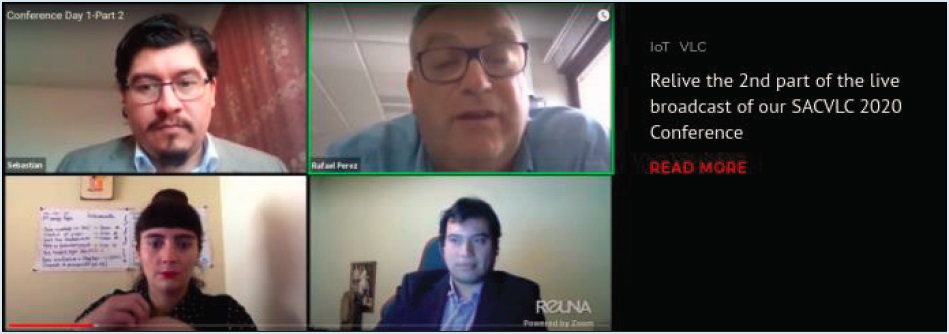
The ComSoc Chile chapter is pleased to announce the sponsorship of the Second South American Colloquium on Visible Light Communications (SACVLC), organized by the University of Santiago de Chile. Visible Light Communications is an evolving research topic, along with a number of new real-life applications.
Visible Light Communications broadens the spectrum of wireless technologies but complements and presents a number of advantages such as increased bandwidth and a focused beam (visible), providing spatial re-use and increased security, as well as the possibility of implementing hybrid systems and indoor and underground location and tracking services.
SACVLC 2020 is a colloquium dedicated to research and development in industry and among academics regarding visible light communications. The development of this type of technology is not only based on the topics of the specific physical layer of light, but also on data communication, and location and detection operated in unlicensed bands.
In 2017, the First South American Colloquium on Visible Light Communications was organized, which took place in the Fundación Telefónica Auditorium, and featured an exhibition of 14 papers by researchers from around the world. This instance counted with four master classes to introduce and explore the current state of the art of VLC from the main leaders of research.
The second VLC Colloquium, called the “South-American Colloquium on Visible Light Communications (SACVLC)”, was held on June 4 and 5, virtually, using the Zoom platform and streaming through YouTube. Thirty-nine papers were received, where 18 were presented in a mode that was due to the pandemic and a previous postponement due to the social outburst. There were up to 31 remote attendees on the Zoom platform, plus approximately 29 attendees on the YouTube simultaneous streaming, who were able to participate actively during the conference.
They presented five Key Note Speakers on the following topics:
-
Dr. Zabih Ghassemloand presenting “Organic LED-basedVisible Light Communications”.
-
Dr. Rafael Pérez Jimenez presenting “Trends on OCC Systems for IoT Applications”.
-
Dr. Marcos Katz presenting “6G and VLC: Opportunities and Challenges”.
-
Dr. Carlos Gutiérrez presenting “The Visible-Light Communications Channel in Vehicular Environments”.
-
Dr. Juan Pablo Hurtado presenting “Ventilation on Demand in Smart Mining Using VLC”.
Among the papers presented, we can highlight advances and comparisons that improve both the sending and processing of signals in VLC in the following works:
-
Performance Analysis of the Bias Tee Circuit in Visible Light Communications.
-
Performance Analysis of OFDM-Based VLC Schemes in NLOS Channels.
-
Hysteresis-based FSK Modulation for Visible Light Communication.
-
Noise Reduction in VLC Channels using Wavelet Multiresolution Analysis.
-
An Alternative to Filters for M-FSK Demodulation in VLC Systems.
All papers are available at https://ieeexplore.ieee.org/xpl/conhome/9126048/proceeding
We can highlight a set of papers that showed applications or potential uses of VLC in different contexts such as education, tourism, positioning and IoT:
-
WORTECS: Enabling Untethered Virtual Reality through Optical Wireless Communication.
-
Comparison of Metaheuristic Optimization Algorithms for RSS-based 3-D Visible Light Positioning Systems.
-
Internet of Things in Smart City Santiago.
-
Interactive Visible Light Communications (iVLC): Supporting Wireless Communications and Smart Visual Interaction with a Common Lighting Infrastructure.
-
The Technological Link to the Communications Service of an Isolated Rural Population Using the Visible Light Communication.
All these works together represent a great advance in VLC, especially because it has been discussed how it can be applied to 6G and how it can be incorporated into more sustainable uses.
For more information about this event, please visit: https://www.sacvlc.cl